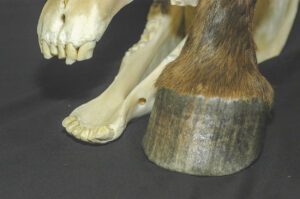Heart Rate Variability to Monitor Unborn Foals’ Health
- Topics: Article, Foal Care, Mare Care, Veterinary Practice
Ultrasound monitoring can reveal important health information about unborn foals, but it’s an invasive procedure that could be unpleasant for the mare. Recent research by scientists in Hungary suggests that a complementary method—fetal heart rate variability analysis, which is carried out with tools that never go inside the mare’s body—could be helpful in monitoring unborn foals’ health.
The fetus’ heart rate (or HR) can tell veterinarians about the unborn foal’s health status at the precise moment of monitoring. But heart rate variability (or HRV) gives a broader and possibly more accurate look at fetal well-being—and it doesn’t require an ultrasound probe, explained Boglárka Baska-Vincze, DVM, PhD, of Szent István University’s Department of Animal Breeding and Genetics, in Budapest.
Heart rate variability is exactly what it sounds like—the way the HR changes, sometimes slowing, sometimes speeding up, including how often and to what extent it changes. And that can provide critical information about health and welfare, including stress, Baska-Vincze said. In equine fetuses, HR changes significantly over the course of the pregnancy, and it can even vary dramatically from one healthy fetus to another. Further, when a fetus moves, that movement will affect the HR at that specific moment. With ultrasound machines, the movement of both the mare and the fetus could obstruct proper HR readings. On the other hand, HRV detected with an external monitor could be a more reliable tool than HR measurements in horses, even if it won’t replace ultrasounds entirely.
“The ultrasound has another task: pregnancy detection at Day 15 and Day 40, rectally,” she said
Create a free account with TheHorse.com to view this content.
TheHorse.com is home to thousands of free articles about horse health care. In order to access some of our exclusive free content, you must be signed into TheHorse.com.
Start your free account today!
Already have an account?
and continue reading.

Related Articles
Stay on top of the most recent Horse Health news with

















